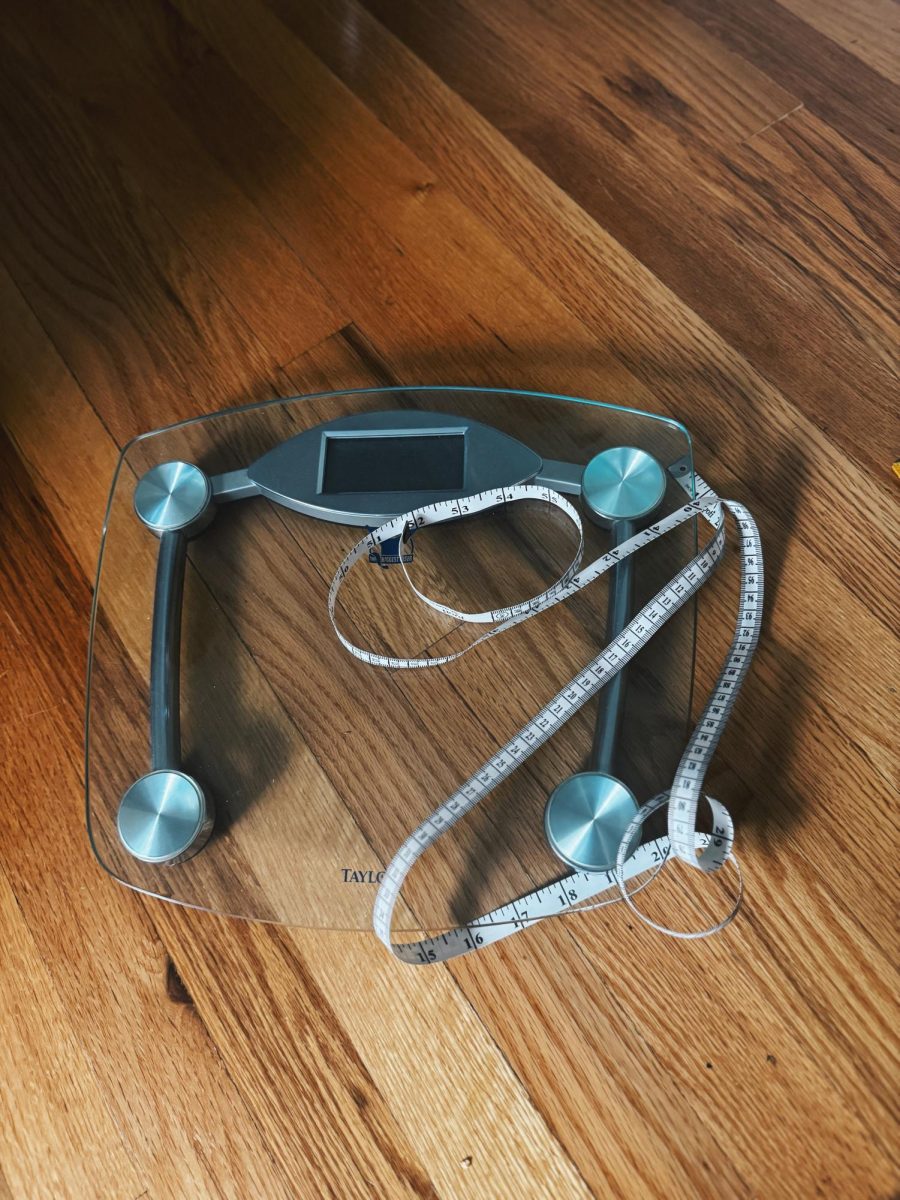Anorexia has the highest mortality rate of any psychiatric disorder. The amount of teenagers affected by various eating disorders has risen at a concerning rate. Between the years 2018 and 2022, the prevalence of eating disorder related medical visits doubled (Journal of Pediatrics). Many factors played a role in this alarming increase, but one of the most harmful things in today’s society turning teens towards disordered eating habits is diet culture in the media.
Anorexia nervosa is the most well known eating disorder, however it is only one of several dangerous forms of disordered eating, each one posing serious risks to mental and physical health, in some cases being fatal. Anorexia is characterized as a fear of gaining weight, with habits like excessive exercise, calorie counting or skipping meals. Among young females aged 15-24, those with anorexia are 12 times more likely to pass away (Eating Recovery Center).
Another common disorder among teenagers is bulimia nervosa, involving cycles of binge eating followed by vomiting, possibly leading to heart problems, electrolyte imbalances, and severe mental health issues.
A lesser known, but just as dangerous disorder is known is orthorexia: the obsession with healthy eating and restrictive eating patterns, which can over time lead to malnutrition, food anxiety and social isolation.
Annie Ryan, an 18 year old who suffered from anorexia opens up about her experience with it. “I was more irritable, depressed and unfocused during this time. I was experiencing jealousy and self hate a lot.”
All of these eating disorders have harmful effects on both physical and mental health. Physically, these eating disorders lead to malnutrition, hormonal imbalance, and have a detrimental effect on growth and development. If disordered habits continue for a longer period of time, effects become more serious with things like heart issues, organ failure and even death. The mental toll is also extensive, causing social isolation and anxiety around food. Depression and anxiety are often associated with eating disorders as well.
“I have clinical depression, which was part of it for sure”, Ryan reflects. “Today, I am medicated for my depression which is an incredible help.”
Understanding what drives so many teenagers to have a disordered relationship with food is a crucial step in prevention. One root cause is diet culture that is present in today’s media.
Today, most teens have a social media presence. TikTok, Snapchat, and Instagram are so common that scrolling has become a part of everyday life. Consuming social media constantly creates exposure to harmful content. The over exposure to unrealistic body standards and emphasis on “clean eating” is the beginning of a dangerous and slippery slope for some towards a very dark outcome.
“I used social media to motivate me, unfortunately. I think our culture is in a very scary shift towards praising thin bodies,” said Ryan. She went on to say that the shift towards a new beauty standard of thin bodies in the media was a factor that drove her to unhealthy eating habits.
Diet culture has been present long before social media. Early forms include magazines with headlines such as “Jessica’s Diet Disaster!” And “The 8 Hour Diet!” After the early 2000’s, focus shifted from magazines to online platforms. Throughout the 2010’s, Tumblr and ED Twitter became platforms where disordered content was being spread. A new kind of content, known as “Thinspo” became more and more prevalent. Thinspo, short for thin inspiration, was images or quotes which would glorify eating disorder behaviors, promote unhealthy bodies as a beauty standard and give weight loss tips which were extremely unhealthy. Quotes such as “Nothing tastes as good as skinny feels” or “Skip dinner, be thinner” began to be posted on these platforms. Notable figures that were posted on these thinspo boards include Kate Moss, the Olsen twins, and Keira Knightley.
While these platforms aren’t as popular with today’s youth, diet culture still exists in a different form. In particular, TikTok is a platform where diet culture is widespread. Videos promoting “clean eating” and the hashtag “Skinnytok” convey toxic and disordered habits. The prevalence of this type of content is shocking.
Today, 27 out of 30 girls surveyed at NPHS report that they have seen some form of diet culture in the last 2 weeks. Lara Illipronti, a sophomore, says she’s seen an alarming amount of videos containing content which is harmful.
“There are these TikToks that are like, ‘what I eat in a day’ and it’s someone eating like, under 1000 calories. I just kind of brush it off, but I know for some people, it can be very impactful, especially for a younger age.”
Maddy DiQuollo, another sophomore, says “I’ve seen videos that like, give tips on how to lose weight with diets like a juice cleanse, or a workout routine and its 2 hours of cardio. I just think that content like this, first of all isn’t realistic and also if the wrong person sees it, it could be harmful.”
Ryan, who made it clear that social media had an effect on her eating disorder, says certain trends she sees today are concerning: “On Tiktok, hostility towards fat people and the uplifting of incredibly thin influencers is becoming more and more prevalent.”
The emphasis that being thin is so important is the main root which can drive teenagers to not be satisfied with their bodies. By setting unrealistic beauty standards, teenagers with impressionable minds are inspired to go to far lengths to be thin. When asked to talk about what they’ve seen on social media, many girls also discussed diets and workout plans which contain borderline disordered habits. Certain videos on weight loss promote diets with 1200 calories a day, or cutting out essential food groups such as carbs. A young teenager who is already dissatisfied with their body seeing such content is bound to fall into the trap and begin starving themselves.
Boys aren’t immune to diet culture either. Connor Killian and Zach Weiss, both sophomores, say that the “gym rat” side of TikTok also creates unrealistic expectations about the value of a certain kind of male body, and how to attain it, especially for teenagers.
“I see bodybuilders that like, probably take steroids, and like, that’s just unrealistic,” Killian said.
“They post diets just eating chicken and rice,” Weiss added.
Social media shapes how teenagers view themselves, and it is important to know the dangers of posting unattainable beauty standards and restrictive practices. These trends are not harmless: they have a direct effect on the mental and physical health of teenagers.
Diet culture also has debilitating effects on those recovering from an eating disorder. The recovery process is long and hard, varying depending on the type and severity. Many patients go through intense clinical recovery. Clinical recovery includes following a strict meal plan with a certain amount of calories to help regain weight, weekly weigh-ins and, in more serious situations, admission into a residential program, where individuals live away from their family and are closely monitored by nurses. Patients also may receive feeding tubes to ensure proper caloric intake. In addition, patients go through therapy. Once the clinical recovery is over, the disordered thoughts don’t simply go away. Recovery is not only the getting back to a healthy, weight, but instead it is a lifelong battle of healing the mind. In fact, only 46% of individuals suffering from anorexia fully recover, and 35% of people experience a relapse within the first 18 months after treatment (Eating Recovery Center). Constant exposure to such toxic content can trigger intrusive thoughts or a relapse.
It is important to understand the harm of diet culture on both young minds and those who are already suffering from eating disorders because understanding the harm is the first step to preventing it. There are many organizations that work to raise awareness and provide resources to patients, such as the National Eating Disorder Association (NEDA), the Eating Recovery Center (ERC), and The Alliance for Eating Disorders Awareness. Organizations such as these work hard to provide support for individuals and their families as well as break the stigma around eating disorders. Supporting these groups can help raise awareness and get people the help they need, while also encouraging creators who are advocating for a change.
Reporting or flagging harmful content can also help reduce the amount of exposure other people get to toxic content. Until a change is made, so many people will continue to suffer in silence, fear, and shame, creating lasting impacts which no one deserves to go through.

